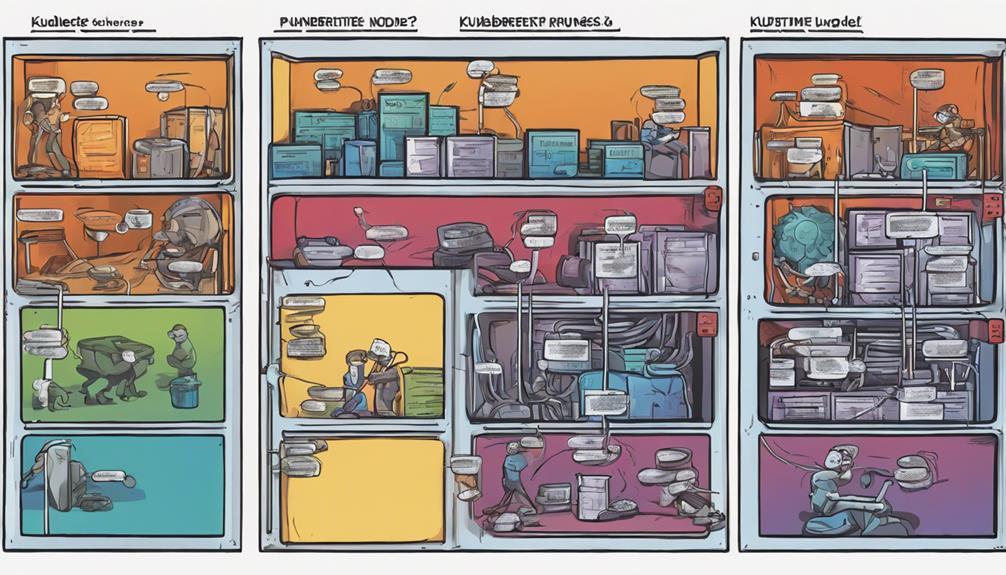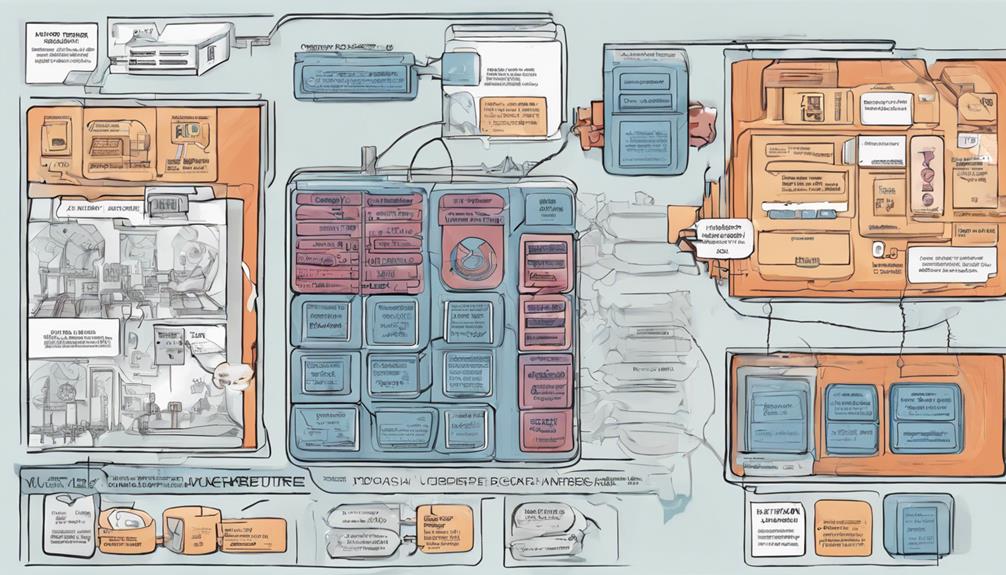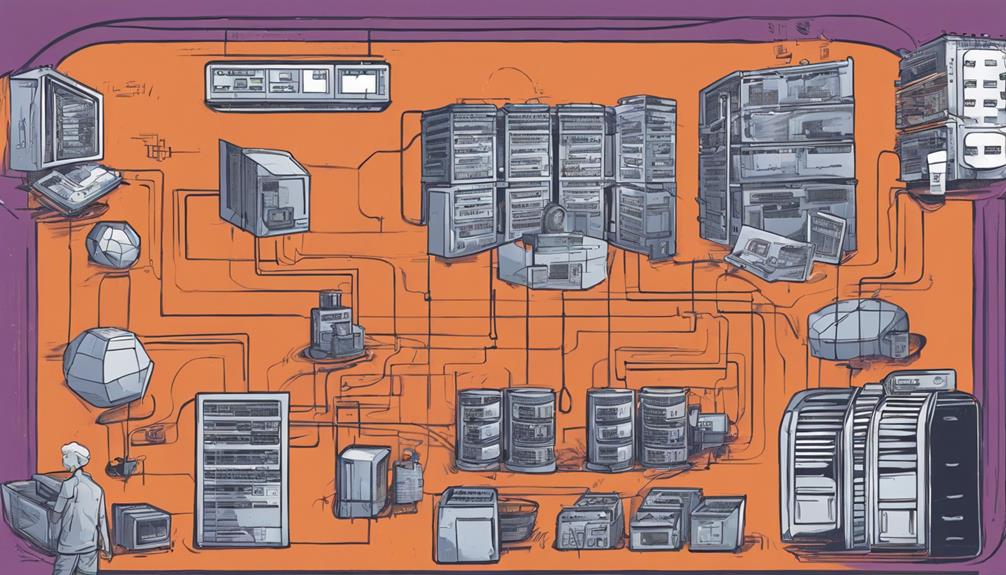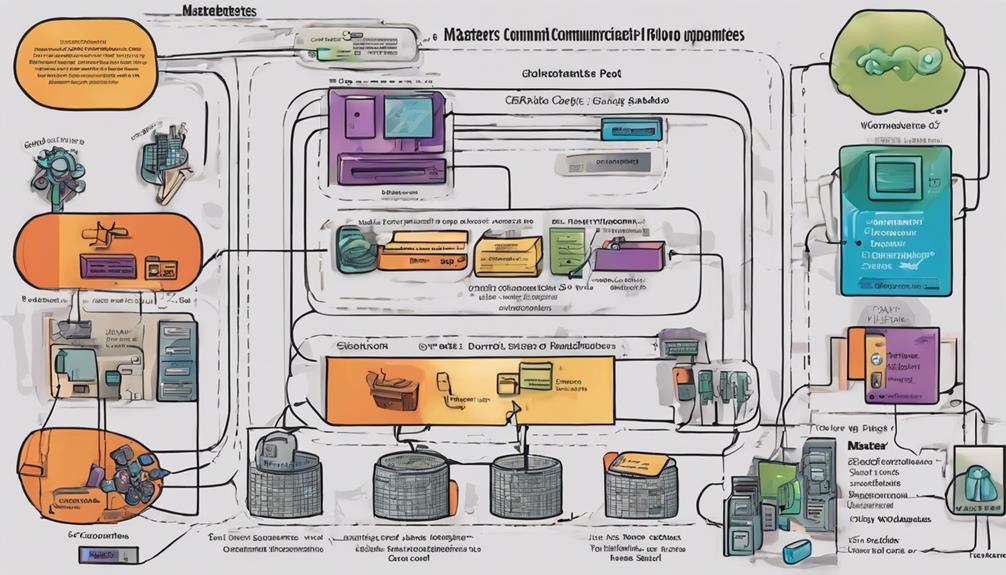In Kubernetes architecture, the Control Plane manages key functions like scheduling and state maintenance. It includes essentials like kube-apiserver and etcd for storage. Nodes host pods with container runtimes, controlled by Kubelet and kube-proxy services. For customization, addons like CoreDNS enhance functionalities beyond basics. Worker nodes guarantee containers' correct operation, backed by Kubelet and container runtime. Efficient network and security operations are pivotal for cluster stability and performance. Explore the intricate workings behind Kubernetes for a deeper understanding of its powerful orchestration capabilities.
Key Takeaways
- Control Plane Components: kube-apiserver, etcd, kube-scheduler, kube-controller-manager, cloud-controller-manager.
- Node Components: Kubelet, Kube-proxy, Container runtime, Pods, Physical/Virtual Machines.
- Responsibilities of Nodes: Running pods, managing containers, and communicating with the control plane.
- Worker Node Operations: Kubelet ensures container operations, Kube-proxy manages network rules.
- Control Plane Management: Orchestrates critical functions, ensures cluster stability, and centralizes global decisions.
Control Plane Components
The Control Plane Components in Kubernetes serve as the brain and decision-making center of the cluster. At the core of these components lies the kube-apiserver, functioning as the API server that external entities interact with to manage the cluster.
Supporting this is etcd, a distributed key-value store essential for storing all cluster data securely.
The kube-scheduler plays a pivotal role in assigning nodes to new Pods, considering factors like resource requirements and constraints for best deployment.
Additionally, the kube-controller-manager orchestrates various controller processes responsible for maintaining the cluster's desired state.
Alongside these components, the cloud-controller-manager bridges Kubernetes with cloud provider-specific integrations, enhancing adaptability and functionality.
Together, these control plane components work in tandem to ensure efficient management, coordination, and operation within the Kubernetes ecosystem, empowering users to handle complex tasks seamlessly and with precision.
Node Components

Let's talk about Node Components in Kubernetes architecture.
You'll explore an overview of these components, understand the responsibilities of nodes, and learn about the operations carried out on worker nodes.
Node Components Overview
Exploring the essential elements on nodes in Kubernetes provides a deeper understanding of the system's architecture.
Nodes, which can be virtual or physical machines, are where pods, comprising containers, run. These nodes utilize a container runtime engine such as Docker, CRI-O, or rkt to manage containers efficiently.
The Kubelet service, acting as an agent on each node, establishes communication with the control plane to guarantee proper orchestration of workloads. Additionally, the Kube-proxy service on nodes handles network routing, facilitating the transmission of UDP and TCP packets within the cluster.
As the fundamental unit of management in Kubernetes, pods enable the execution of multiple interdependent processes concurrently on nodes. Understanding the roles of these components is essential for comprehending how Kubernetes efficiently manages containerized applications across distributed environments.
Responsibilities of Nodes
Nodes in Kubernetes, responsible for running pods with containers, play pivotal roles in the system's architecture. Each node, whether physical or virtual, hosts a container runtime engine like Docker, CRI-O, or rkt to manage containers efficiently. The Kubelet service on nodes acts as an agent, facilitating communication with the control plane to receive instructions on pod deployment and management. Additionally, the Kube-proxy service on nodes is responsible for managing network routing, ensuring that UDP and TCP packets flow correctly between pods on the same node or different nodes. Pods, the fundamental unit of deployment in Kubernetes, enable running multiple interconnected processes seamlessly on nodes. Below is a table summarizing the key responsibilities of nodes in the Kubernetes architecture:
| Node Components | Responsibilities |
|---|---|
| Kubelet service | Acts as an agent communicating with the control plane. |
| Kube-proxy service | Manages network routing for UDP and TCP packets between pods. |
| Container runtimes | Manage containers on nodes efficiently. |
| Pods | Core unit for running multiple dependent processes on nodes. |
| Physical/Virtual Machines | Host nodes that run pods composed of containers. |
Worker Node Operations
Worker node operations in Kubernetes are vital for managing containerized workloads efficiently within the cluster. To guarantee smooth execution and communication, several key components play pivotal roles on worker nodes:
- Kubelet: Acts as an agent on worker nodes, ensuring that containers are running as expected.
- Kube-proxy: Manages network rules on worker nodes, facilitating communication within the cluster.
- Container runtime: Responsible for the execution of containerized applications on worker nodes.
These components work together to execute containerized applications, enforce network rules, and maintain seamless communication with the control plane for effective management of workloads.
Worker nodes are fundamental in the Kubernetes architecture, and the proper functioning of these components is essential for the overall performance and reliability of containerized workloads within the cluster.
Addons Plug-in

Let's explore how Kubernetes addons plug-ins enhance your cluster capabilities.
Key functionality like networking, monitoring, logging, and security are essential for optimizing your Kubernetes environment.
Understanding these addons will help you leverage their benefits effectively.
Key Addons Functionality
Explore the diverse range of functionalities that Kubernetes addons offer, enhancing your cluster with features like networking, storage, and monitoring capabilities. These addons play a pivotal role in extending the core functionalities of Kubernetes, providing additional tools and services to optimize your cluster's performance.
Here are a few key addons and their functionalities:
- CoreDNS: Enables DNS resolution for service discovery within the cluster, ensuring seamless communication between different components.
- KubeVirt: Allows you to run virtual machines alongside containers in Kubernetes, expanding the range of workloads that can be managed within the cluster.
- ACI: Integrates Azure Container Instances, offering on-demand container execution capabilities that enhance the flexibility of your Kubernetes environment.
Enhanced Cluster Capabilities
Discover how Kubernetes addons plug-ins enhance your cluster's capabilities by providing essential functionalities like CoreDNS and Calico. CoreDNS facilitates DNS-based service discovery and load balancing within the cluster, ensuring efficient communication between services.
Additionally, KubeVirt enables the simultaneous operation of virtual machines and containers, offering versatility in workload management. The ACI addon seamlessly integrates with Azure Container Instances, allowing for flexible deployment of workloads across platforms.
Besides, Calico plays a pivotal role in the cluster by enforcing network policies and establishing secure network connectivity. By leveraging these addons, you can enhance your cluster's performance, scalability, and security.
Whether you need robust service discovery, efficient load balancing, or stringent network policy enforcement, Kubernetes addons provide the necessary tools to optimize your cluster's capabilities and streamline operations effectively.
Commands for Kubectl

To interact effectively with Kubernetes clusters, understanding the essential commands for Kubectl is important. The Kubectl command-line tool allows you to interact with Kubernetes clusters efficiently.
Here are three key commands you should be familiar with:
- `kubectl create`: Use this command to create resources like Pods, Services, Deployments, and ConfigMaps within your Kubernetes cluster.
- `kubectl get`: Utilize this command to retrieve information about various Kubernetes resources present in the cluster, such as Pods, Services, Deployments, and ConfigMaps.
- `kubectl describe`: This command provides detailed information about a specific resource in your cluster, helping you troubleshoot issues or monitor the state of your resources effectively.
Worker Node Operations

Understanding the main role of worker nodes is important for the operational efficiency of a Kubernetes cluster. Worker nodes play a significant part in the execution of containerized applications and handling tasks assigned by the control plane.
The Kubelet serves as the agent on worker nodes, facilitating communication with the Kubernetes control plane, while the Kube-proxy is responsible for managing network rules and enabling communication within the cluster on each worker node.
Container runtime engines such as Docker, CRI-O, or rkt are utilized to run containerized applications on these worker nodes. Various worker node components collaborate to guarantee the proper operation and management of containers within the cluster, contributing to the seamless execution of tasks and maintaining effective communication and network rules.
Essentially, worker node operations are crucial for the successful deployment and management of containerized applications in a Kubernetes environment.
Control Plane Management

Worker nodes play a pivotal role in Kubernetes operations, now shifting focus to Control Plane Management, where global decisions and cluster management are centralized.
The control plane in a Kubernetes cluster orchestrates critical functions such as scheduling, maintaining cluster state, and handling cluster-wide events.
Here are three important aspects of Control Plane Management:
- Control Plane Components: Components like kube-apiserver, etcd, kube-scheduler, and kube-controller-manager are integral to controlling the cluster's behavior and state.
- Highly Available Clusters: To secure resilience, control plane components can be distributed across multiple machines, enabling the setup of Highly Available clusters.
- Component Configuration: Tools like kubeadm aid in configuring control plane components, optimizing their performance and stability within the cluster architecture.
Customization and Extension

Customization and Extension in Kubernetes involves tailoring components and functionalities to meet specific operational needs and enhance cluster capabilities. Custom schedulers can be developed to work alongside the native scheduler, enabling customized workload distribution.
The Kube Controller Manager plays an essential role in ensuring the desired cluster state by managing various controllers, including custom ones. Additionally, the Cloud Controller Manager facilitates seamless management of cloud-specific resources by bridging Cloud Platform APIs with Kubernetes.
Kubernetes supports the use of custom plugins and scheduling frameworks, offering flexibility and extended functionality for cluster operations. By customizing Kubernetes components, organizations can create tailored solutions that meet their specific requirements and optimize workflows efficiently.
These customized solutions play an important role in enhancing cluster operations, making Kubernetes a versatile platform for various organizational needs.
Networking and Security

To guarantee efficient communication between pods and maintain secure cluster operations, Kubernetes leverages CNI plugins for networking interfaces and implements PKI certificates with TLS encryption for component communication.
When it comes to networking and security in Kubernetes, here are some key points to bear in mind:
- CNI plugins: These plugins play an important role in providing network interfaces for containers, enabling seamless communication between pods within the cluster.
- Communication security: Kubernetes ensures secure communication between its components by utilizing PKI certificates and TLS encryption, safeguarding data in transit.
- Backup strategies: Given the critical role of etcd in storing Kubernetes objects and maintaining cluster stability, having strong backup strategies is essential to mitigate the impact of any potential outages and ensure data resilience.
Understanding these aspects is essential for effective management of the Kubernetes network and security protocols, ensuring smooth cluster operations and data integrity.
Frequently Asked Questions
What Is the Kubernetes Architecture in Simple Terms?
In simple terms, Kubernetes architecture comprises control plane and worker nodes. The control plane manages cluster orchestration, while worker nodes run containerized apps. Pods are key for managing processes. High availability, scalability, and security are emphasized.
What Is Kubernetes Explained in Detail?
In detail, Kubernetes is an open-source platform automating deployment, scaling, and management of containerized apps. Its architecture includes control plane components like API server, scheduler, etcd, and worker nodes running apps efficiently.
What Is Kubernetes Network Architecture and How Does It Work?
To understand Kubernetes network architecture, grasping how CNI plugins facilitate pod communication across nodes is crucial. This guarantees secure networking with encryption and authentication. Despite its complexity, Kubernetes offers flexible solutions like Calico and Flannel for diverse needs.
What Are the Four Components of Kubernetes?
To understand Kubernetes, know its key components: kube-apiserver, etcd, kube-scheduler, and kube-controller-manager. They collaborate to manage containerized applications efficiently, ensuring scalability and reliability in your cluster's operations.
Can You Explain the Detail of Kubernetes Architecture?
Kubernetes architecture breakdown complete is a complex system that consists of various components such as nodes, pods, services, and volumes. It is designed to orchestrate containerized applications, providing scalability, automated deployment, and management. The architecture includes a master node for controlling the cluster and worker nodes for running the actual workloads.
Conclusion
As you explore the intricate details of Kubernetes architecture, you'll find yourself marveling at the seamless integration of Control Plane Components, Node Components, and Addons Plug-in.
With commands for Kubectl at your fingertips, worker node operations become a breeze.
Control Plane Management allows for effortless customization and extension, while networking and security are seamlessly integrated.
It's no coincidence that Kubernetes has become the go-to platform for container orchestration.









